Minh-Van Nguyen
PRS-Med: Position Reasoning Segmentation with Vision-Language Model in Medical Imaging
May 17, 2025



Abstract:Recent advancements in prompt-based medical image segmentation have enabled clinicians to identify tumors using simple input like bounding boxes or text prompts. However, existing methods face challenges when doctors need to interact through natural language or when position reasoning is required - understanding spatial relationships between anatomical structures and pathologies. We present PRS-Med, a framework that integrates vision-language models with segmentation capabilities to generate both accurate segmentation masks and corresponding spatial reasoning outputs. Additionally, we introduce the MMRS dataset (Multimodal Medical in Positional Reasoning Segmentation), which provides diverse, spatially-grounded question-answer pairs to address the lack of position reasoning data in medical imaging. PRS-Med demonstrates superior performance across six imaging modalities (CT, MRI, X-ray, ultrasound, endoscopy, RGB), significantly outperforming state-of-the-art methods in both segmentation accuracy and position reasoning. Our approach enables intuitive doctor-system interaction through natural language, facilitating more efficient diagnoses. Our dataset pipeline, model, and codebase will be released to foster further research in spatially-aware multimodal reasoning for medical applications.
Sing-On-Your-Beat: Simple Text-Controllable Accompaniment Generations
Nov 03, 2024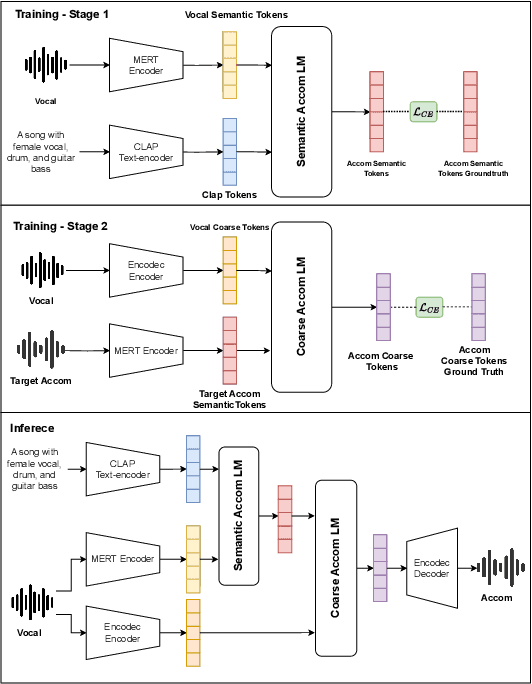



Abstract:Singing is one of the most cherished forms of human entertainment. However, creating a beautiful song requires an accompaniment that complements the vocals and aligns well with the song instruments and genre. With advancements in deep learning, previous research has focused on generating suitable accompaniments but often lacks precise alignment with the desired instrumentation and genre. To address this, we propose a straightforward method that enables control over the accompaniment through text prompts, allowing the generation of music that complements the vocals and aligns with the song instrumental and genre requirements. Through extensive experiments, we successfully generate 10-second accompaniments using vocal input and text control.
ALGNet: Attention Light Graph Memory Network for Medical Recommendation System
Dec 09, 2023Abstract:Medication recommendation is a vital task for improving patient care and reducing adverse events. However, existing methods often fail to capture the complex and dynamic relationships among patient medical records, drug efficacy and safety, and drug-drug interactions (DDI). In this paper, we propose ALGNet, a novel model that leverages light graph convolutional networks (LGCN) and augmentation memory networks (AMN) to enhance medication recommendation. LGCN can efficiently encode the patient records and the DDI graph into low-dimensional embeddings, while AMN can augment the patient representation with external knowledge from a memory module. We evaluate our model on the MIMIC-III dataset and show that it outperforms several baselines in terms of recommendation accuracy and DDI avoidance. We also conduct an ablation study to analyze the effects of different components of our model. Our results demonstrate that ALGNet can achieve superior performance with less computation and more interpretability. The implementation of this paper can be found at: https://github.com/huyquoctrinh/ALGNet.
M^2UNet: MetaFormer Multi-scale Upsampling Network for Polyp Segmentation
Jun 14, 2023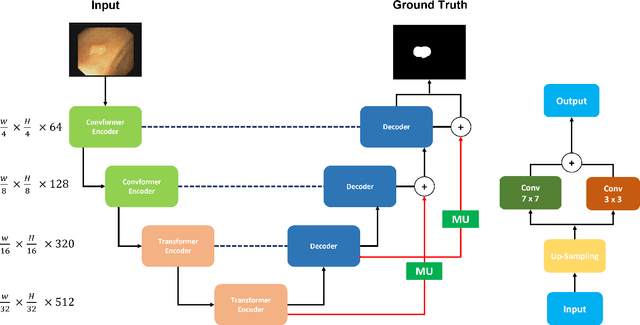
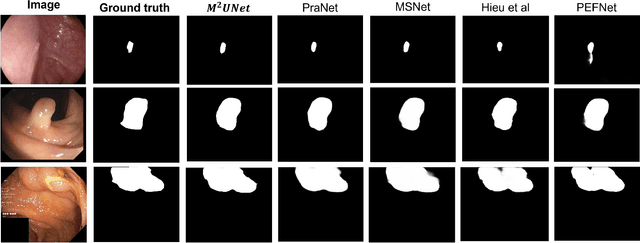
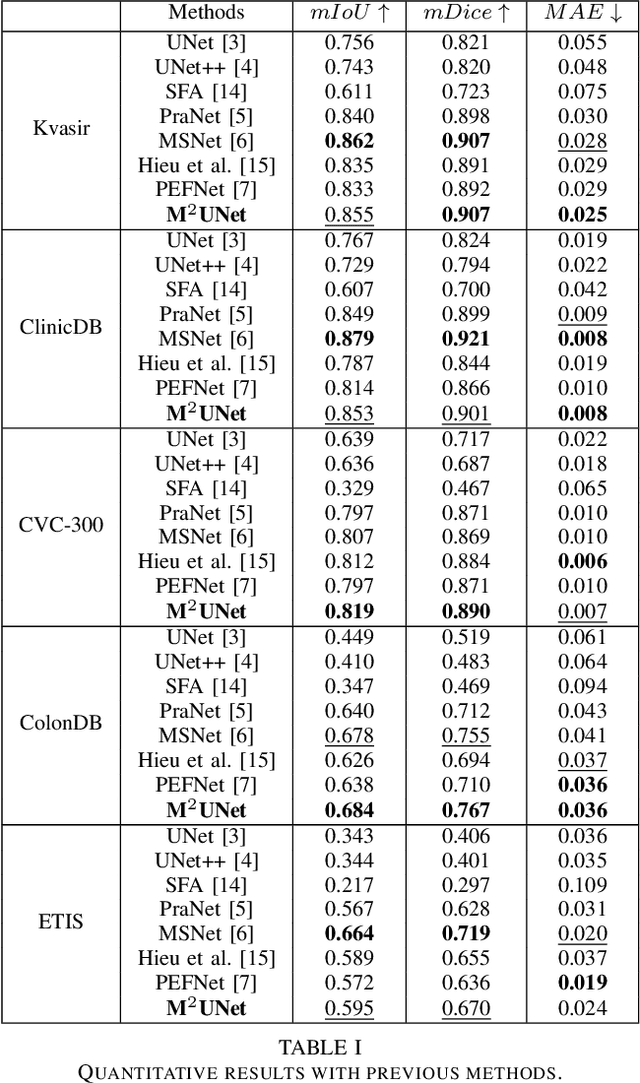
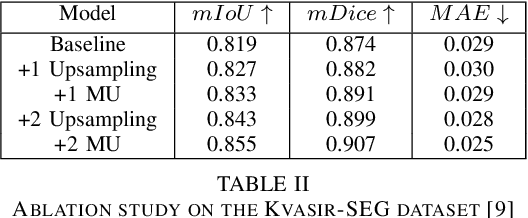
Abstract:Polyp segmentation has recently garnered significant attention, and multiple methods have been formulated to achieve commendable outcomes. However, these techniques often confront difficulty when working with the complex polyp foreground and their surrounding regions because of the nature of convolution operation. Besides, most existing methods forget to exploit the potential information from multiple decoder stages. To address this challenge, we suggest combining MetaFormer, introduced as a baseline for integrating CNN and Transformer, with UNet framework and incorporating our Multi-scale Upsampling block (MU). This simple module makes it possible to combine multi-level information by exploring multiple receptive field paths of the shallow decoder stage and then adding with the higher stage to aggregate better feature representation, which is essential in medical image segmentation. Taken all together, we propose MetaFormer Multi-scale Upsampling Network (M$^2$UNet) for the polyp segmentation task. Extensive experiments on five benchmark datasets demonstrate that our method achieved competitive performance compared with several previous methods.
EfficientNet for Brain-Lesion classification
Aug 09, 2022Abstract:In the development of technology, there are increasing cases of brain disease, there are more treatments proposed and achieved a positive result. However, with Brain-Lesion, the early diagnoses can improve the possibility for successful treatment and can help patients recuperate better. From this reason, Brain-Lesion is one of the controversial topics in medical images analysis nowadays. With the improvement of the architecture, there is a variety of methods that are proposed and achieve competitive scores. In this paper, we proposed a technique that uses efficient-net for 3D images, especially the Efficient-net B0 for Brain-Lesion classification task solution, and achieve the competitive score. Moreover, we also proposed the method to use Multiscale-EfficientNet to classify the slices of the MRI data
Res-Dense Net for 3D Covid Chest CT-scan classification
Aug 09, 2022Abstract:One of the most contentious areas of research in Medical Image Preprocessing is 3D CT-scan. With the rapid spread of COVID-19, the function of CT-scan in properly and swiftly diagnosing the disease has become critical. It has a positive impact on infection prevention. There are many tasks to diagnose the illness through CT-scan images, include COVID-19. In this paper, we propose a method that using a Stacking Deep Neural Network to detect the Covid 19 through the series of 3D CT-scans images . In our method, we experiment with two backbones are DenseNet 121 and ResNet 101. This method achieves a competitive performance on some evaluation metrics
Refined Deep Neural Network and U-Net for Polyps Segmentation
May 31, 2021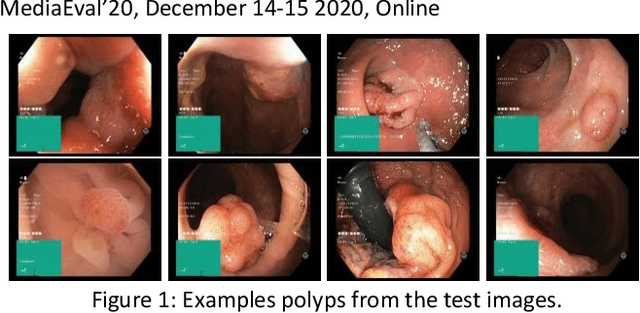

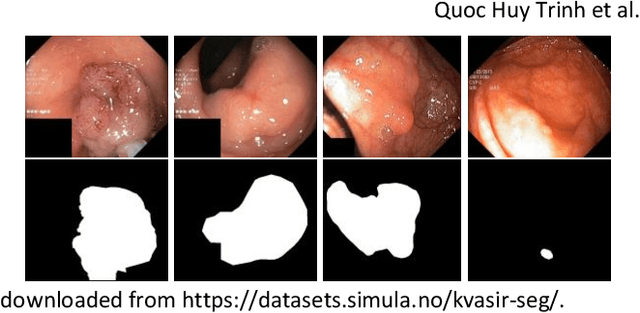
Abstract:The Medico: Multimedia Task 2020 focuses on developing an efficient and accurate computer-aided diagnosis system for automatic segmentation [3]. We participate in task 1, Polyps segmentation task, which is to develop algorithms for segmenting polyps on a comprehensive dataset. In this task, we propose methods combining Residual module, Inception module, Adaptive Convolutional neural network with U-Net model, and PraNet for semantic segmentation of various types of polyps in endoscopic images. We select 5 runs with different architecture and parameters in our methods. Our methods show potential results in accuracy and efficiency through multiple experiments, and our team is in the Top 3 best results with a Jaccard index of 0.765.
 Add to Chrome
Add to Chrome Add to Firefox
Add to Firefox Add to Edge
Add to Edge